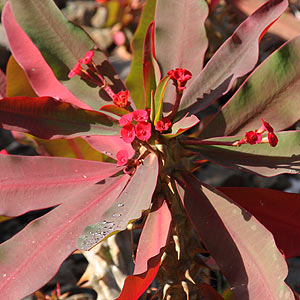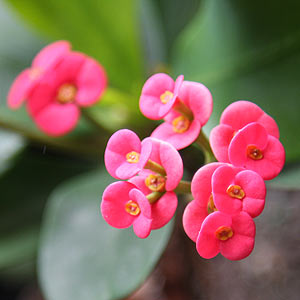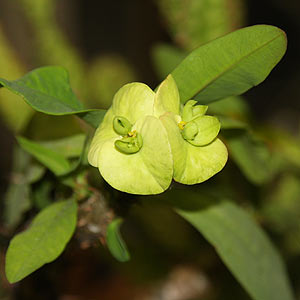The ‘Crown of Thorns’

Although Euphorbia millii is better known as the ‘Crown of Thorns’ those that we see in cultivation are mainly hybrids. These are a succulent plant however they do require a little more water than most.
With bare stems that are covered with rows of sharp thorns, the contrasting crown or foliage and attractive flowers give this plant a bit of a dual personality.
This is a long flowering plant, the main flowering time is in the winter months, although spot flowers will appear throughout the year. When grown indoors, it can flower almost continually, although it is best to try to give the plant a rest during the summer months.

Used widely as indoor plants, they will also grow well in the garden in the warmer zones. The hybrids vary greatly in size, from large growing plants similar to the species, to smaller more compact forms.
Care
The essential element in growing Euphorbia millii is a well drained growing media. They need to be watered in a manner where the water flows quickly through the drainage holes in the pots.
The growing medium needs to dry almost completely between waterings. Euphorbia millii are however fairly forgiving as long as they not overwatered or grown in constantly moist potting medium.
- Temperature – Euphorbia millii are frost tender, they will survive cold temperatures, however frost will damage them. They do not seem to ming extreme heat and also cope well with low humidity.
- Light – The amount of light will depend on the temperature, for those in warmer zones a 20 – 30% shade cloth or filtered light in the afternoon works well. Deep shade will inhibit flowering. In all cases at least 4 hours or morning sun is required.
- Disease Prevention – Fungal problems can occur in times of high humidity, however if you keep the plants clean, by removing dead foliage and any debris beneath the plant much of this can be controlled.
- Fertilizer – A general purpose slow release fertiliser applied in spring and summer seems sufficient.

Pruning
To maintain a compact bushy plant pruning will eventually be required. You do need to wear protective clothing and glasses as the sap is toxic.
Clean cutting tools are essential, so sterilise secateurs before pruning.
Try to prune back to buds, many euphorbia rate reluctant to re shoot from older woody stems. Be more inclined to tip prune regularly rather than hard prune.
Repotting
Best carried out in summer with plants repotted slightly deeper than they were previously. This is another way of shortening the length of tall stems, rather than pruning.
Euphorbia milii -Varieties
As with so many plants the hybrids offered for sale increase the variety both in plant size and flower color.
Many of the hybrids offered are smaller growing, and the flower colors vary from rosy red to pale pink, yellow, white and also green. You will also find that the hybrids are more floriferous than the species in most cases.
Many of these hybrids have been developed in Thailand, known both as Thai hybrids and Poysean hybrids. Poysean being the Chinese name for Euphorbias milii. These have been widely exported and are now available around the world.
You will see these sold as Euphorbia x lomi with this referring to the parentage, many being E. milii and E. lophogona crosses. So E. x lomi ‘Salmon’ has the Salmon Pink flowers which are very popular.
Care is the same for all.

